March 26, 2012
By Jeff Weakley
Miami Full Circle
After all the years, still a center of innovation in offshore light-tackle fishing.
If you're familiar with Philip Wylie's tales of charterfishing adventures, first published in the Saturday Evening Post in the 1940s, you might recognize two guys running a 42-foot sportfisher in downtown Miami.
Crunch and Des are alive and well, and their names are Jimbo and Rick Thomas.
The forty-something brothers are cut right out of the original mold that produced Wylie's title characters, not to mention real-life angling pioneers Bill Hatch, Tommy Gifford, Bob Lewis and countless others.
Miami, you see, wasn't always defined by crooked politicians, cocaine cowboys and sky-high condos. The subtropical port town is in fact the birthplace of modern light-tackle bluewater sportfishing. I find it fitting that each morning, the Thomas Flyer, fighting lady yellow Awlgrip glistening in the sunrise, goes to sea with the ghost fleet of old Pier 5.
The docks of Miamarina at Bayside, where the famous tourist pier used to be, sure have changed over the last seven decades. A good deal of boat traffic in this neck of Biscayne Bay consists of tourists gawking at celebrity homes. Million dollar megayachts share the water with multi-level, salsa-blasting cocktail cruisers. Fishing is in some ways a side show, but the good news is, it's just as productive, and thrilling, as ever.
After dodging morning rush-hour on I-95, I joined Jimbo and Rick for a full-day charter. Loading up drinks were native Miamian Graylan Franklin and three Germans who make regular forays to this international hub: Thomas Leifert, Larry Saretski and Roland Doerner.
First order of business was getting live bait. In Wylie's breezy, fictional narratives, Captain Crunch and first mate Des trolled rigged mullet and bonito strips. Anglers of that era would be shocked at how easy it is to catch live pilchards and herrings with color sonar and sabiki rigs. Not marking any inside Government Cut proper, we stopped at an oceanside range marker.
With healthy grassflats inshore, extensive reefs offshore, Miami is seen by some anglers as South Florida's repository of pilchards and herrings. We recognized a couple of boats down from Broward County, just catching bait, penning them up for a tournament the following week. Just over Sandman's T-top, a little farther offshore, I could see bait taking to the air, scattering from a toothy wave of mackerel, kingfish, bonito, who knows.
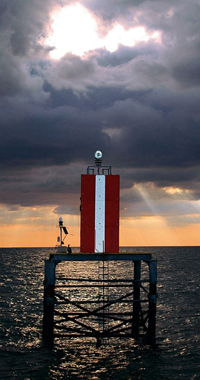
Where a lot of great days begin, at the mouth of Government Cut. |
“Probably mackerel,” Jimbo said. “Sometimes sails come in this close, but they usually keep going—see how those fish are kind of staying in one area.”
Variety is one of the things that defines Miami fishing. The other is sheer convenience. You get bait 365 days a year; you don't have to run far to find fish.
Three miles off Key Biscayne, in depths from 40 to 300 feet, are numerous wrecks and artificial reefs—at last count over 50, with hundreds more in other county reef zones. The early 1980s were the hey-days of reef-building for Miami-Dade County, when fishing clubs got involved. Those wrecks—and some new ones—are still producing fish.
“We learned to fish these by using ranges on shore,” Jimbo said, when I ribbed him about a tiny black-and-white GPS on the bridge of Thomas Flyer. The brothers don't skimp on quality gear. They have high-end Daiwa reels and custom Vandemark rods, everything from yellowtail sticks to marlin rigs, and an endless supply of terminal gear. As for navigational help, no fancy chartplotter needed off Miami. Just ranges and bearings to spots named for their primary residents: AP for African pompano, for instance.
We were talking about grouper at one point, when Jimbo revealed a seasonal connection I found interesting.
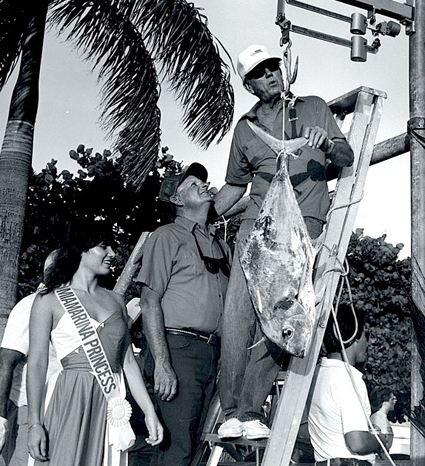
From the FS archives, Senior Editor Vic Dunaway helps the late Bob Lewis weigh in an African Pompano at the Metropolitan South florida Fishing Tournament, late 70s. |
“Even on these reefs, it's all about bait,” he began. “We find pinfish out on deep reefs; I think they must spawn offshore—we start seeing schools around the range marker in November, December, and my guess is they keep moving out to the reefs. That's right about time the jacks show up, followed by the grouper.”
I had asked about groupers during lunch, mainly because it seemed the hard-hitting bottom fish were about the only thing Graylin and his buddies would not be taking home today.
The loading of the fish box started in about 100 feet of clean blue water. Rick put a nose-hooked herring on a starboard flatline, then another port, then one down the middle with a couple of egg sinkers rigged on the leader. The flatlines he raised on outriggers, opening up the transom, where he could add a second set of baits, if desired.
Jimbo, at the wheel up top, kept the bow into the 10-knot north wind, bumping in and out of gear. The ride was smooth and the baits stayed out back, thanks to a south current.
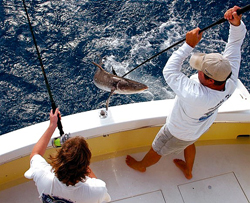
Rick Thomas gaffs a cobia for Larry Saretzki. |
The net movement of the Gulf Stream through the Straits of Florida is north, but “over the reef,” basically inside 120 feet, counter-currents can move in any direction, sometimes based on tide, sometimes wind, sometimes on what color shirt you decided to wear.
North current is preferable for sailfish action, but it changes from day to day—even by the hour. Anglers looking at satellite imagery before bed are often stumped in the narrow, 50-mile river between peninsular Florida and the Bahama Banks. By the time you wake up, it's all changed.
I knew we had an action-packed day ahead, when our first bite was a kingfish on the deep herring, followed by a barracuda on the kingfish. Some days the ocean is alive. This was one of them.
Larry—who'd never fought a saltwater fish—pulled in a 20-pound cobia, which ate a deep herring in open water. Later in the day, his buddy Roland caught one even bigger, again in the same manner. A third cobia, barely larger than a typical remora, came to the boat for dehooking.
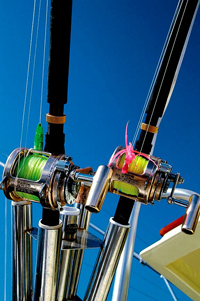
High-speed dolphin rigs stand ready for deployment when running from spot to spot. |
“They must be moving through,” Jimbo said. “In winter, if you get a sunny, calm day, you can fish cobias on the stingrays inshore. But sometimes we get them like this, just cruising the deep.”
We tried a few drops on deep wrecks, using a 2-pound sash weight and a three-way swivel rig on 50-pound gear, but no takers. It seemed the bottom fish were AWOL. Jimbo and Rick don't spend much time on a spot, if nothing's marking on the sonar. Not to be denied, Roland picked up a 6-pound mutton snapper on a slow-trolled surface bait.
“That happens sometimes,” Jimbo said with a grin. “I've seen ‘em hit kite baits; big black groupers do that, too.”
There'd been some reports of dolphin the last few days, and Jimbo called down to Rick: “Let's do a loop offshore and see what we find.”
Rick brought in the livebait gear and put out a pair of 30-pound trolling outfits with small lures. One had a double-hooked bonito belly strip. We soon had a double-header of schoolies in 700 feet of water, along a weedline. Four more fish came on the troll, and Thomas caught the biggest, a cow of about 17 pounds, on a live herring.

Roland Dorner's mutton snapper took a live herring on a slow-trolled flatline. |
A couple of boats on the radio, VHF channel 80, reported sailfish releases. The sea state off Key Biscayne looked ideal—north, northeast wind, 2-foot chop, blue water—but that south current sat with us all day, delivering plenty of mixed bag bites.
Miami anglers set on getting a sailfish bite are known to pick up and move as much as 20 miles north or south at a reliable radio report. Some days the bite is best off Key Largo; other days it's right near the Sea Buoy off Government Cut. A good day in Miami is as good as anywhere in the world. On charter or tournament boats set up to handle multiple strikes, 10-fish days aren't uncommon.
If you put in your time, a sailfish will eventually come calling. It may take a trip or two, but it'll happen. I know this from personal experience. When I lived in Miami, my own boat was 17 feet—not the kind in which you'd go screaming off to the horizon in typical 3- to 4-foot winter chop. Most days we'd start off catching bait, bump our way out to the Sea Buoy, then drift on back to Haulover Inlet. Haulover is the next inlet north of Government Cut, just over eight nautical miles. My logbook for that brave little vessel shows at least one sailfish release pretty much every other trip, between December and May.
I think Graylin and crew forgot all about sails after dolphin number eight hit the planks.
“Fish like this, they pay a lot of money for in Germany,” Thomas said. “A fine restaurant, as much as $600 a plate.”
Soon the guys were bundling up plastic baggies of fillets in a cooler, with ice chips. They planned to get dry ice for the long flight home.
While they worked, I ordered fried softshell crab sandwiches from Tradewinds, a new restaurant at Bayside. Jimbo whittled away with the fillet knife; Rick rinsed off tackle.
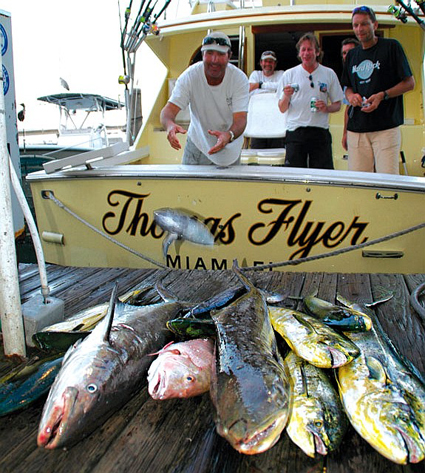
Anglers pile up eatin' fish at Miamarina, a tradition little changed since the 1950s. |
It was a timeless scene, classic Miami sportfishing, little changed in 70 years. I opened a cold gold beverage and toasted to old Pier 5.
Circle Hooks for Tournaments
Miami was the center of innovation in Atlantic sailfish tactics, where Bill Hatch developed the dropback; Tommy Gifford the modern outrigger; and Bob Lewis the fishing kite as we know it.
Still is.
Today almost exclusively the province of livebait fishermen, Miami is a beacon of billfish conservation advocacy. The Yamaha Contender Miami Billfish Tournament, an all-release event, was the first to mandate catch and release, in the 1980s, and to require circle hooks of its fleet, in 2004, said Joan Vernon, recently retired from the board of directors. “Miami has always been a leader, taking a lead in doing what's best for fish,” she said, “and I think it will continue to do that.” As of January 2008, the National Marine Fisheries Service (NMFS) requires circle hooks on all billfish tournament vessels using natural bait.
Globe-trotting, record-setting Capt. Skip Smith, a tireless advocate for billfish conservation, testified to the effectiveness of these hooks at a seminar at the University of Miami Rosenstiel School on Virginia Key.
Smith had a great prop—a 5-gallon bucket and a circle-hook rigged lure. Toss the lure in the bucket, pull the line off to the side and back, and as the lure slides around the lip of the bucket, the hook latches into place. The mechanics—particularly with the non-offset circle hooks—greatly reduce the likelihood of snagging the gut or throat of a sailfish or other catch to be released.
“Teenagers have proven that you can live with a little extra jewelry in the mouth,” he said. That got the crowd chuckling.
Rick Thomas says Thomas Flyer uses J-hooks on mixed-bag charters, but rigs them with a thin black rubber band bridle, same as is advocated for use with circle hooks. “We like to bridle just about everything,” he explained. “Helps keep the hook from doubling back into the bait.”
The Billfish Tournament website is:
www.miamibillfish.com.
Editor's Note: Content for this article was excerpted from “Angling & War: The Collision of Big Game Fishing and WWII,” 2007, Silverfish Press. For this coffee-table format color book, author Mike Rivkin compiled a fascinating account of how World War II influenced changes in boat and engine design, maritime safety and fishing gear. Furthermore, a great many of today's popular fishing destinations were first explored by servicemen on distant deployments. It's a great read.
Miami Anglers Helped Save the World
Live-saving tackle and skills helped turn the tide of World War II.
By Mike Rivkin
Few states topped Florida in contributing to the Allied war effort during World War II. More than 250,000 Floridians donned uniforms against the Axis, and the state's agricultural output helped feed troops around the world. As wartime demand for labor surged, workers from the Dust Bowl states streamed south and east. The boatyards, factories and fields were all hiring fast, and soon the Depression was little more than a bitter memory. By decade's end, the state's population had grown by almost half. In the meantime, Florida's energy and output helped win the war for the Allies, and Florida anglers came to play a unique and critical role. Here's how.
While WWII turned out well for the Allies in the end, the beginning was not very encouraging. After the devastating losses at Pearl Harbor and elsewhere in the Pacific, things turned even worse the following year. In 1942 alone, Allied losses totaled 1,664 ships—almost five per day. More than 20,000 merchant mariners were killed or wounded during the war, making it statistically the most dangerous of all wartime duties.
In the air, the U.S. Army Air Force recorded losses of more than 45,000 aircraft, of which slightly more than half were incurred during combat operations. Of those, more than 4,500 planes went down in the waterlogged Pacific theatre. In short, many were the American airmen or sailors that found themselves adrift and abandoned at sea.
Fortunately, downings at sea often resulted in near-immediate rescue by adjacent vessels or search parties, leaving the men involved with harrowing tales to tell but little else. While that may have been somewhat comforting, not all of the GIs dumped into the sea were so lucky. Indeed, the U.S. War Department suppressed many of the more ghoulish stories, such as the one in which a life raft was found along a South American beach containing a dead airman, six other ID tags, and a colonel's insignia that had been fashioned into a primitive fish hook. The fact was that if a serviceman was lost at sea and not recovered almost right away, he was in trouble.
As the horror stories began to pile up, the Navy was finally moved to act. A new advisory group called the Life Saving Board of the Navy and Coast Guard had been formed early in 1942 and had spent the year reading harrowing stories of survival at sea. They concluded that much of the problem lay with the antiquated emergency survival gear stowed aboard many life rafts. Little had been done to improve the gear since the turn of the century, and most traumatized servicemen found the hodge-podge assortment virtually useless. With this in mind, the Board turned to celebrated naturalist Gifford Pinchot for his input. Pinchot, widely regarded as the father of the American conservation movement, had served as the nation's first director of the U.S. Forest Service and was a two-time governor of Pennsylvania. He was also a widely traveled angler and had authored several popular books on his adventures. In turn, Pinchot approached his friend Dr. Alexander Wetmore of the Smithsonian Institution, and it was Wetmore who hit upon the idea of approaching some of Florida's most accomplished anglers to assist with the design of a new kit.
The first on board was Mike Lerner, already a legendary Florida angler and founder of the International Game Fish Association (IGFA) just three years before. Within days, he had rounded up his most able saltwater fishing cronies and pressed them into service as committee members. All had strong Florida ties. The participants included angler/ authors Kip Farrington and Philip Wylie, Julian Crandall of Ashaway Line & Twine, Miami boat captain Bill Hatch and others. Lerner and his veteran crew subsequently spent more than two rigorous months researching and testing a variety of suitable gear off the Miami coastline.
The final kit, formally known as the United States Navy Emergency Fishing Kit, came in two sizes. The first and largest was a full-featured kit weighing 3 pounds and featuring a 12-pocket apron filled with all manner of fishing gear. Designed for use aboard U.S. Naval and merchant vessels greater than 3,000 tons, the assemblage was packed in a sealed coffee can and then stowed along with other emergency gear aboard deck-mounted life rafts. Shortly thereafter, a second kit was introduced for aviation cockpits consisting of a smaller 1-pound, 2-ounce collection of tackle housed in an eight-pocket apron. In order to reduce both the size and weight of the airborne kit, the coffee can and various bits of duplicate tackle were omitted. Among the items to pass Lerner's muster was bait in the form of dried pork rind, 700 feet of fishing line, assorted hooks and lures, a harpoon head specially developed for both gaffing and spearing, and various other necessities such as a net, sharpening stone, knife and a pair of gloves.
Most critically, both kits also included detailed instructions printed on waterproof paper. Written in clear uncomplicated English, the document combined morale-boosting exhortations (e.g., “Keep cool and use your head.” “Never give up.”) with a wide variety of useful information. Each element in the kit was addressed as to its use and maintenance, and subjects such as how to dry fish, catch turtles, and utilize the feathers of sea birds were briefly but thoroughly covered.

After heavy fighting in distant Pacific saes, the U.S. Navy began looking at ways to improve survival gear for airmen and sailors. Angling lumnaries Kip Farrington (left) and Mike Lerner inspect an emergency kit developed and tested in Miami. |
Some of the instructions, which we include herein, contain advice as relevant to today's high-tech anglers as to WWII servicemen in dire straits.
As a final rite of passage before the finished kits were presented to the Navy for approval, Lerner and his team traveled to Miami where they were deposited offshore in life rafts in order to field-test each element of tackle. While this was quite a different thing than meeting at Lerner's sumptuous New York apartment, each member of the group gamely made at least one foray offshore with emergency kit in hand. During one field test, Wylie actually found himself temporarily lost at sea, an embarrassing goof he later memorialized in one of his short stories featuring the mythical Miami charter boatmen Crunch and Des. The real-life incident involved a two-man test pairing Wylie with angler and Miami Herald columnist Erl Roman off the Florida Keys. The two were field-testing a prototype kit in a rubber life raft when a U.S. Coast Guard cutter approached and inquired as to their business. Even though a smaller Coast Guard craft was nearby, having accompanied the two men as they drifted about in their little boat, the test was not listed on the day's activity roster and some quick explaining was required to satisfy the larger vessel.
The Roman/Wylie test spawned one more wry anecdote. The men's final duty of the operation was to capture a shark in order to photograph how such a beast might be discouraged from inspecting either hooked baits or the raft itself. Unfortunately, there were no sharks about that day, even after the crew dumped 40 gallons of beef blood and mounds of chopped fish at a notoriously shark-infested location. That evening, Roman and two others went out in a larger craft with every conceivable piece of gear in order to catch the required specimen. Still no sharks. Finally, when the group returned to Florida, a cash bounty was offered to the fishing public if anyone could deliver a shark to the now-desperate testing committee—up to $20 for a large one, and less for smaller models.
After several days of considerable effort up and down the entire southeast Florida coastline, one modest-size shark was finally captured and the job was done.
Formally adopted by the U.S. Navy in February of 1943, the new emergency fishing kits were ultimately deployed by the thousands in U.S. Navy, Coast Guard and Maritime Commission vessels, plus the Army Transportation Corps and a number of other Allied nations. By 1944, survival manuals for all services were exhorting lost sailors and airmen to make sure that cans of fishing gear accompanied them into their rafts. Those that didn't were left with troublesome alternatives. While U.S. Navy survival manuals offered instruction in how to make your own fishing line (“unravel canvas or fabric from trouser leg and weave into twisted line”), hooks (“use wood from raft bench or floating debris, shoe nails, safety pins, etc.”), and lures, their advice was not confidence-inspiring. The kit's proven efficacy was also in marked contrast to an announcement by Canadian authorities in January of 1943 of their intention to augment lifeboat stores with 35 ounces of rum, 180 cigarettes, and the large-headed “wind” matches needed to light them...in addition to some assorted bits of tackle. As for sharks, they were dismissed as harmless and inclined to approach life rafts only to rub sea lice from their skin. Such inaccuracies would later prove to be deadly wrong.
Nonetheless, in fulfilling his critical mission quickly and well, Lerner and his team had done an exemplary job in assembling the new emergency fishing kits. Subsequent deployments in all theatres confirmed their worth beyond a doubt. Once approved by the Navy, the firm of Ashaway Line & Twine led the manufacturing effort, dedicating its full resources to developing exact specifications, lining up sub-contractors, securing the necessary approvals, and establishing delivery dates. More than 500,000 kits were constructed, ultimately saving hundreds of lives. A group of dedicated anglers had done its best for the war effort, and it was enough.
Lost at Sea?
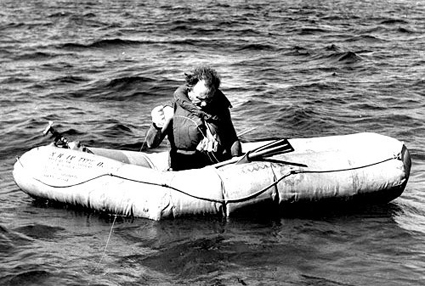
Michael Lerner field-testing actual survival gear. |
Survival fishing tips, as printed in WWII U.S. Navy Emergency Fishing Kits. Most of this advice is still relevant to modern anglers. Except maybe the parts about eating turtles and seagulls...
Fish is Food and Drink:
If you can catch fish, you will not die of hunger or thirst. If and when you have caught more fish than you can eat, squeeze out or chew out the juice of the flesh and drink it. Fish juice tastes much like the juice of raw oysters or clams. It has been tested and found safe.
Among General Rules:
• Try to catch small fish rather than large ones. Big fish, such as large sharks, may break lines, carry off baits, cut your hands, and make other trouble, or even upset your boat.
• Keep your bait moving to make it look alive. A moving bait is better than a still bait.
• Be sure to keep a part of any bird or fish you catch to use for bait. Fresh bait is better than the pork rind in your fishing kit.
• After using, clean your hooks and lines of fish and fish slime. Wind them up again as they were in the kit, see that hooks are not sticking into lines, dry them in the sun, and return them to the cloth pockets, and keep them dry if you can. While drying, always slide your feather jig up the wire to keep the feathers from rusting against the hook.
• Keep your fishing tackle in a safe place or lash it in, when not in use, so that it cannot be lost overboard, even if your boat should turn over.
• Be very careful not to get your lines tangled or to let hooked fish tangle them. Two men, one at side, one at stern, can fish at the same time, but they must watch out. Never leave your line where it can be stepped on, and keep it from wearing itself out by cutting into or rubbing against the gunwale.
• Be sure every man in your company gets his fair share of whatever you catch.
• Keep on fishing and watching for fish. You never know when a fish may bite.
Fishing Tackle and How to Use It:
If you have no bait left, slip or tie a white or pearl button off your shirt on the hook and keep it moving, sometimes slow, sometimes faster. (Otherwise), cut from your shoe a small, narrow strip of leather or canvas, an inch long for small fish, longer for bigger fish.
About Fishing:
• Fish do not bite well at a hook with seaweed on it. Watch your hooks and keep them baited and clear.
• If you hook a fish too big to handle, give him as little line as possible. That way, you will have more line left after he breaks it.
• Watch for schools of fish. You may see them breaking water. Large fish will probably be near schools of small fish. Get up to such schools if you can.
• If you have some fish to spare, you can often catch more by chumming. Cut pieces of fish very fine and scatter them in the water. Chum only if the boat is moving slowly or not at all.
Fishing with a Light:
Fish often come to a light at night. If you see flying fish at night, hoist your sail or hang up your shirt or any other white cloth. Shine the light of your flashlight on it. Flying fish will often jump at it and fall into the boat. Often the bright moon shining on the white cloth will draw the fish. A light thrown on the water at night will sometimes bring flying fish and other small fish. Catch them with your net. They are good to eat.
Sharks, Skates and Rays:
Sharks have killed many men. Stay out of the sea and in the boat when sharks or other large fish are around. Many a man has lost a hand or foot by letting it hang overboard.
Splashing with an oar or striking at it will usually drive a shark away. The tenderest spot in a shark is the end of his nose. His gills come next.
Do not fish when sharks are around. They may cut your lines. Let sharks alone if you can get other fish.
Turtles:
The whole meat, blood and juice of a turtle are good to eat. There is good meat against the shell under the backbone. Cut through the ribs to get at it. After a turtle's head is cut off, the head may bite and the claws may scratch. Watch out. Hot sun brings a clear oil out of turtle fat. Dip your food in it.
Birds:
All birds are good to eat, cooked or raw. Their blood and livers are eatable (sic). Birds will sometimes light on the boat or on your back or head. Catch every bird you can. Save the feathers. Use them to make fishing jigs. Stuff them inside your shirt to keep you warm, [or] dry the skin with the feathers on it...and use it to wrap around your neck or cover your back.
Whales:
Do not worry about whales. The chances are millions to one they will do you no harm.
FS

